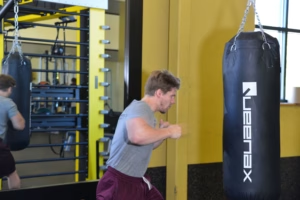WHAT DOES A
PERSONAL TRAINER DO?
Do you want to get fit, but don’t know where to start? A personal trainer can help! In this video, we’ll talk about what personal trainers do and how they can help you reach your fitness goals.
LEARN WHAT PERSONAL TRAINERS DO!
Hey there, I’m Tom with Platinum Fitness Training. Oftentimes, I’m asked, “What does a personal trainer do?” My answer isn’t necessarily a short one.
Comprehensive Consultation
The first job of a personal trainer when taking on a new client is to do a comprehensive consultation. A consultation has three parts: medical history, fitness history, and a goals assessment. The medical history is important to ensure that the program created is safe for the client, considering any and all injuries and physical limitations and being generally aware of anything that could pose a problem once training begins. The fitness history of the client gives the trainer the info they need to establish a jumping-off point. We don’t want the program to be too advanced, which has a risk of resulting in injury, nor do we want the program that is too easy, to begin with.
A good trainer thinks long-game results take time. Slow and steady generally wins the race. The trainer needs to have an accurate account of what the client is looking to achieve. This will dictate the complexion of the program. Weight loss, cardiovascular health and conditioning, strength gain, injury prevention, flexibility, mobility, and functional strength are just a few goals clients have.
Regular Training Sessions
Once a PT has all this info, they’ll begin to build the client’s program. Most clients work with a trainer twice a week. A trainer will prescribe functional warmups, cardio, and post-workout stretching outside these sessions. Sometimes a trainer will prescribe resistance training programming for the client outside the session. If a client has body composition goals, whether that’s weight loss, fat loss, strength gain, or weight gain, we have to take into account nutrition. We have to offer guidance. At the end of the day, calories do matter.
PTs like to say that the easy part is making the initial program because once we begin, the client’s unique physicality begins to adapt and/or react to the program, and then the real work begins. Trainers need to pivot, adjust programming, and improvise on the fly as this process unfolds. A good trainer has many tools in their belt to make adjustments to a program. The PT can change the exercise, the weight, the reps, the sets, the tempo, and the frequency. Sometimes goals change, and it’s time for a completely new program. A good trainer needs to be a limitless source of knowledge.
Support Long-Term Results
Trainer needs to listen to their clients, but just as important, they need to be in tune with their client’s physical response to the workouts. A PT needs to know when the workout is too intense or when the client isn’t giving enough effort. A good personal trainer is a motivator, a coach, an influencer, and an all-around resource for their clients. There’s a mental component that a trainer has to be in tune with. All clients are motivated differently; a trainer must be the key to continually unlocking that. A good PT does not necessarily need to be a bigger-than-life personality. They don’t need to be a cheerleader necessarily. They need to be committed to forming a positive and influential relationship with each client, providing guidance and inspiration with regard to their fitness lifestyle.




